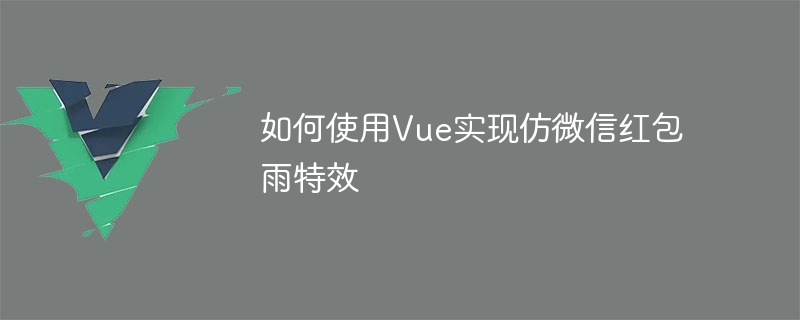

How to use Vue to implement imitation WeChat red envelope rain special effects
Introduction:
WeChat red envelope rain is a very popular interactive activity, people can watch it on their mobile phone screen You can see the red envelope dropping effect on the screen and click to receive it. This article will introduce how to use the Vue framework to implement WeChat-like red envelope rain special effects, and provide specific code examples.
I. Preparation
Install the required dependencies in the Vue project:
npm install vue-router --save npm install axios --save
src/ Prepare the image resources for red envelope rain (red envelope images and background images) in the assets directory. II. Create a component
Create a component named RedPacket to represent a red envelope:
<template>
<div class="red-packet" :style="packetStyle" @click="openPacket">
<img :src="packetImg" class="red-packet-img" alt="How to use Vue to implement WeChat red envelope rain special effects" >
</div>
</template>
<script>
export default {
props: ['packet'],
computed: {
packetStyle () {
return {
top: `${this.packet.y}px`,
left: `${this.packet.x}px`
}
},
packetImg () {
return require('../assets/red-packet.png') // 替换为实际红包图片路径
}
},
methods: {
openPacket () {
this.$emit('open', this.packet)
}
}
}
</script>
<style scoped>
.red-packet {
position: absolute;
width: 50px;
height: 50px;
}
.red-packet-img {
width: 100%;
height: 100%;
}
</style>Create a component named RedPacketRain to represent the effect of red envelope rain:
<template>
<div class="red-packet-rain">
<img src="../assets/background.png" class="background" alt="How to use Vue to implement WeChat red envelope rain special effects" >
<red-packet v-for="packet in packets" :key="packet.id" :packet="packet" @open="handleOpenPacket" />
</div>
</template>
<script>
import RedPacket from './RedPacket'
export default {
components: {
RedPacket
},
data () {
return {
packets: [],
timer: null
}
},
mounted () {
this.startRain()
},
methods: {
startRain () {
const { clientWidth, clientHeight } = document.documentElement
this.timer = setInterval(() => {
const x = Math.random() * (clientWidth - 50)
const y = -50
const id = Date.now()
this.packets.push({ id, x, y })
}, 500)
},
handleOpenPacket (packet) {
// 处理点击红包的逻辑
}
},
beforeDestroy () {
clearInterval(this.timer)
}
}
</script>
<style scoped>
.red-packet-rain {
position: relative;
width: 100%;
height: 100%;
overflow: hidden;
}
.background {
position: absolute;
top: 0;
left: 0;
width: 100%;
height: 100%;
z-index: -1;
}
</style>III. Use red envelopes on the page Rain component
In the page that needs to use the red envelope rain effect, introduce the RedPacketRain component:
<template>
<div class="red-packet-page">
<red-packet-rain />
</div>
</template>
<script>
import RedPacketRain from '../components/RedPacketRain'
export default {
components: {
RedPacketRain
}
}
</script>
<style>
.red-packet-page {
width: 100%;
height: 100vh;
}
</style>IV. Extra Function
handleOpenPacket method, such as popping up a dialog box to receive a red envelope or jumping to the red envelope details page. Through the above steps, we can implement WeChat-like red envelope rain special effects in the Vue project. I hope this article will be helpful for you to learn the Vue framework and implement special effects!
The above is the detailed content of How to use Vue to implement WeChat red envelope rain special effects. For more information, please follow other related articles on the PHP Chinese website!